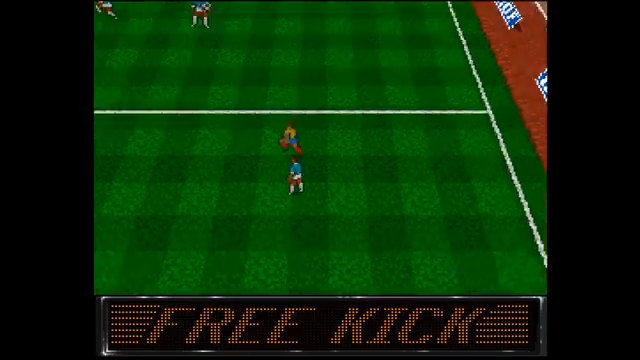Is a soccer cart that lets you bicycle-kick from midfield, edit a 3-5-2 diamond on battery back-up, and cram four sweaty friends onto one floral couch a bizarre relic or an unsung classic? (Spoiler: it’s both, so don’t play coy.) World Cup Striker, pal-region face of Rage Software’s Striker engine, rechristened Elite Soccer in the USA, landed in late 1993, months before EA’s first FIFA shook the snow-globe. Underrated? Absolutely; the game rarely makes retro top-tens yet hides ideas modern footy still copies. Overrated? Only if you can’t process rubber-band ball physics and phantom off-sides in the same brain space. Fundamental? It’s the scrappy winger sprinting past history’s back four, reminding us 16-bit football once experimented like a Mad Scientist of Mode 7.

Historical Context
Rage, a fledgling Liverpool studio, had shipped the Amiga original a year earlier; Elite Systems bought console rights and squeezed the code onto a 16-megabit SNES ROM, small by ’93 standards. Multiregion branding followed: Europe kept World Cup Striker, France borrowed Cantona’s ego for Eric Cantona Football Challenge, and Acclaim slapped Elite Soccer on U.S. shelves. The import shop near XP Arcade touted “4-player compatible!”, a claim Usenet lists soon confirmed, slotting the cart among the SNES’s rare multitap footy titlesg.
In market terms, Rage’s top-down perspective filled a vacuum: Konami’s International Superstar Soccer was a year away, and EA’s isometric FIFA International Soccer hadn’t yet flicked its broadcast-camera revolution. Striker therefore enjoyed a brief, bright window where its elastic physics and DIY tactics editor felt cutting-edge rather than quaint.
Mechanics (a.k.a. When the Ball Behaves Like Flubber)
Everything pivots on that elastic ball. Shots bend comically; rebounds ricochet as if the sphere’s carved from trampoline rubber. VGJunk’s deep dive calls the curl “hefty enough to embarrass Roberto Carlos”, and it’s no exaggeration. Hold Y, tap left or right, and watch 16-bit leather boomerang around keepers who sprint off their line at a 45-degree angle every single time (a quirk Fullsnes’s opcode notes tie to a unique RAM wrap Rage employed).
Controls stay mercifully three-button: B for ground pass or shoulder barge, Y for power shot, A for lob or slide tackle. Hold R to sprint, though an invisible stamina stat bleeds speed if abused, a design wrinkle Rage imported from earlier micro-computer sims. Off-ball AI presses zonally until you mash turbo, whereupon defenders swap to man marking, often vacating the opposite flank (a gift to counter-attacks and couch trash-talk alike).
The roster screen scrolls far beyond a single page, 128 editable nations, according to the series wiki and ROM data for the U.S. build. Even the PAL cart exposes over sixty squads; for teenage me that meant pitting Iceland against Bolivia just because the fixture would never exist on television. Hidden stats, Pace, Technique, Stamina, Keeper Skill, govern acceleration curves and shot spin, though reviewer anecdotes agree long-range howitzers still thud harmlessly into goalie chests unless you exploit the near-post chip.
Presentation toggles carry flavor. Select strict refereeing and whistles shriek after the gentlest nudge; pick lenient and you’ve entered a Mortal Kombat crossover (VGJunk’s screencaps show “Ref Needs Glasses” banners mocking missed hacks). Weather options coat pitches in rain that doubles surface friction, shrinking Brazil’s speed advantage, my friend’s go-to equalizer when dragging underdog Saudi Arabia into overtime.
Set pieces trigger brief Mode 7 zooms, throw-ins, goal kicks, free kicks spin the pitch like a dizzy drone shot before snapping back to top-down. It’s equal parts gimmick and charm, proof Rage wanted SNES muscle flex even in a cart half EA’s size.
Multiplayer remains the cart’s crown jewel. Plugging a Hudson Super Multitap unlocks two-versus-two World Cup brackets the manual touts as “up to five people”, keeper AI counts as the fifth slot in crazy marketing math. Google Group veterans still rate it “one of the best 4-player soccer games” on the platform. Friendly-fire slide tackles hilariously ignore cards, so your own teammate can suplex you mid-breakaway without red-card drama, a feature we weaponized into couch politics well before Mario Kart’s blue shell.
Legacy and Influence
Though eclipsed commercially by FIFA and Konami, World Cup Striker planted tactical seeds still visible. Its drag-and-save formation editor predates EA’s custom tactic slots by years. Four-pad co-op foreshadowed N64’s six-human ISS marathons and modern couch indies like Super Arcade Football, whose dev blog name-checks Rage’s exaggerated curl as inspiration.
The codebase enjoys a cult among ROM modders: forums host patched “Striker 2023” builds with updated kits and keeper-charge nerfs. Fullsnes technical notes highlight Rage’s peculiar PC-to-ROM opcode wrap, a quirk emulators had to special-case, making the game a minor celebrity in SNES dev circles.
Why niche, then? Lack of licenses, player names are fictional, and the arrival of EA’s fully endorsed kits mere months later siphoned mainstream attention. Reviews praised pace but slammed the camera for “ice-rink overscroll,” and North American buyers gravitated to NBA Jam’s razzle-dazzle instead.
Collectors see modest demand: PAL carts hover around €25 loose on eBay listings, while an Australian big-box edition with tactics poster cracked AU$380 in 2022 auction chatter. The NTSC manual omits the squad-select musical riffs still present in PAL ROMs, a trivia tidbit speed-run commentators love to drop mid-match footage.
Closing Paragraph + Score
Boot a match today and the screen floods with trampoline passes, keepers dashing like wind-up toys, and midfield carnage that could stand as a crash course in pixelated Schadenfreude. World Cup Striker is the extrovert uncle of SNES football: loud, generous, occasionally embarrassing, but always ready for “one more” even at 3 a.m. beneath a snack-crumbed couch. Behind its rubber-band theatrics hides a thoughtful tactics sandbox and one of the era’s few true four-player sports brawls.
Score: 7 / 10, bump it to eight if you’ve got a multitap and three equally reckless friends; drop it to six if phantom off-sides make you rage-quit before halftime. Either way, give Rage’s underdog another run, modern football could still use a little elastic nonsense.